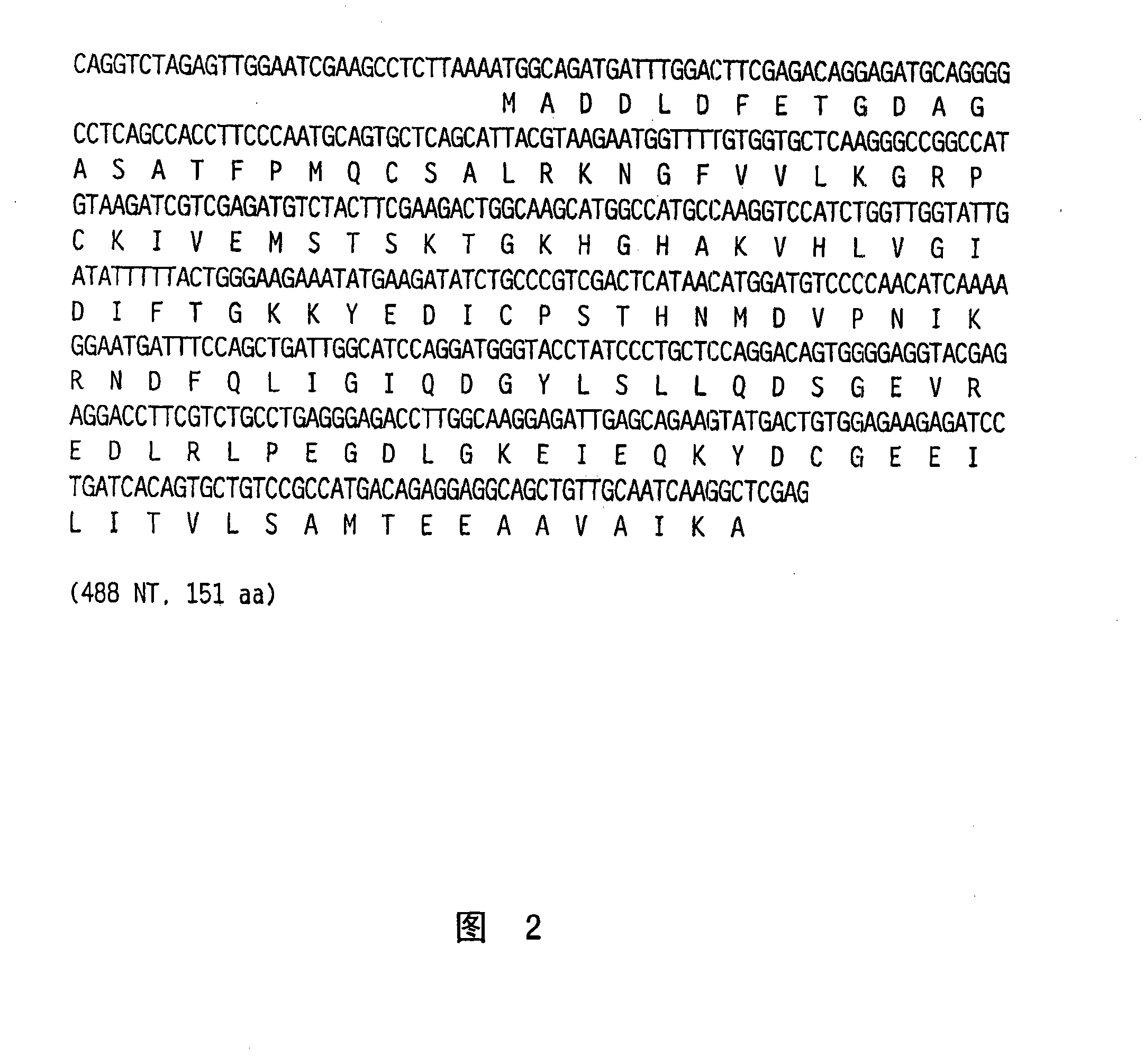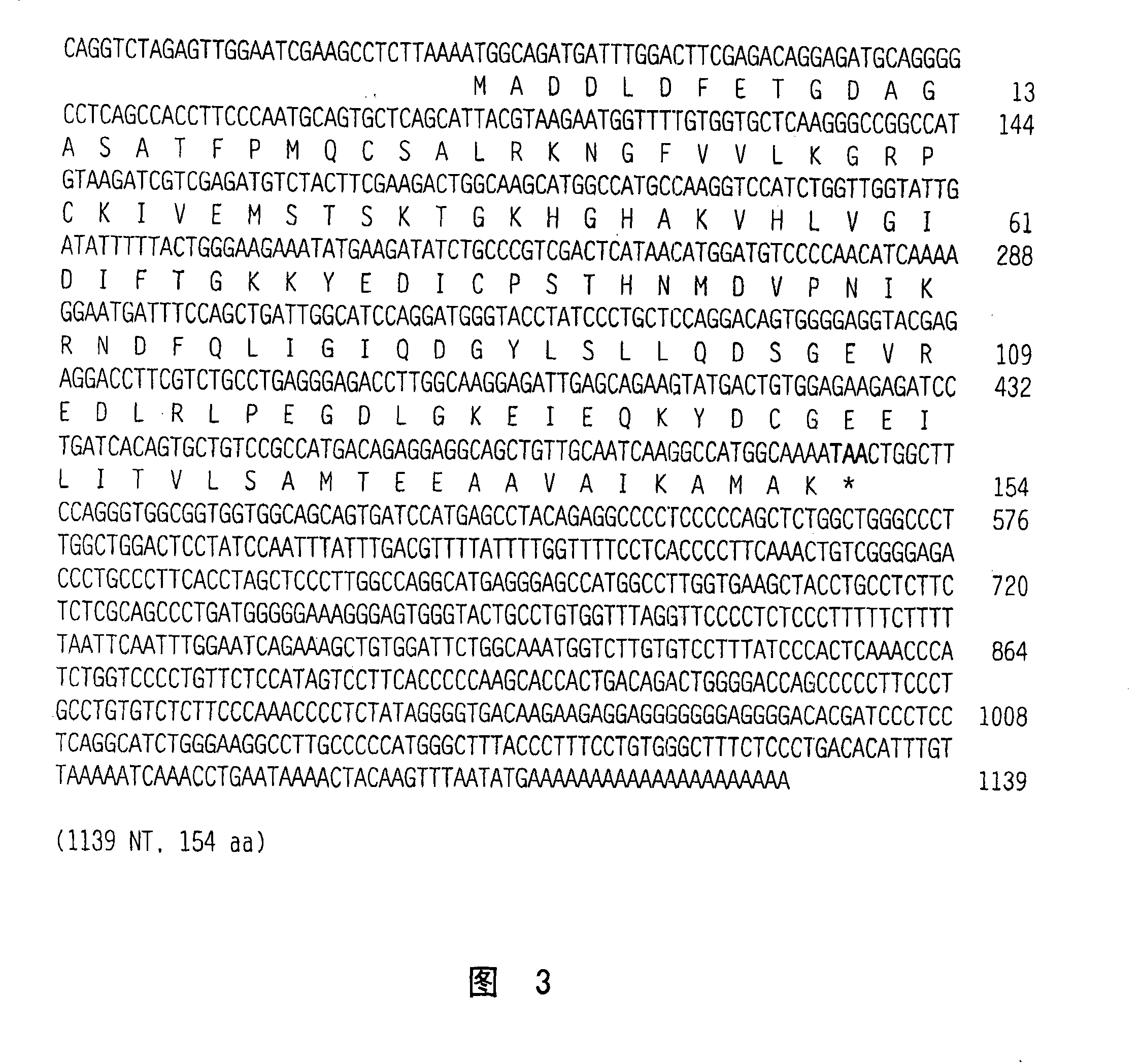Nucleic acids, polypeptides, and methods for modulating apoptosis
A technology for apoptosis and cancer cells, applied in the fields of nucleic acid, polypeptide, and regulation of cell apoptosis, which can solve the problems of normal cells having little effect and failing to occur in time.
- Summary
- Abstract
- Description
- Claims
- Application Information
AI Technical Summary
Problems solved by technology
Method used
Image
Examples
Embodiment 1
[0134] This example demonstrates the isolation and characterization of a full-length cDNA encoding a rat eIF-5A nucleic acid with apoptosis-specific expression.
[0135] Superovulation and induction of apoptosis in rat corpus luteum
[0136] Subcutaneously inject 50 IU of PMSG (pregnant mare serum gonadotropin) to immature (21-30 days old) female rats, and 60-65 hours later, inject 50 IU of HCG (human chorionic gonadotropin) to make It superovulates. After being treated with HCG for 7 days, 500 mg of PGF-2α was subcutaneously injected to induce apoptosis of corpus luteum cells. After treatment with PGF-2[alpha], rats are sacrificed at various times (eg, 1, 8, and 24 hours), and the corpus luteum is excised and placed in liquid nitrogen. The corpus luteum tissues of the control group were obtained from rats sacrificed immediately before PGF-2α treatment.
[0137] Dispersion of luteal cells in rat ovary
[0138] Six to nine days after superovulation, rats were subcutaneously...
Embodiment 2
[0174] This example demonstrates the regulation of apoptosis using apoptosis-specific eIF-5A and DHS.
[0175] Culture of COS-7 cells and isolation of RNA
[0176] COS-7, an African green monkey kidney fibroblast-like cell line transformed with an SV40 mutant encoding wild-type T antigen, can be used for all transfection-based experiments. COS-7 cells were cultured in Dulbecco's modified Eagle's medium (DMEM) containing 0.584 g L-glutamine, 4.5 g glucose, and 0.37% sodium bicarbonate per liter. The medium was also supplemented with 10% fetal bovine serum (FBS) and 100 units of penicillin / streptomycin. cells at 37°C, 5% CO 2 and 95% air humid environment to grow. Every 3-4 days, the cells were cultured again by detaching adherent cells with a solution of 0.25% trypsin and 1 mM EDTA. Disperse the isolated cells at a ratio of 1:10 in a new Petri dish containing fresh medium.
[0177] COS-7 cells used for RNA isolation were grown in 150-mm tissue culture dishes (Corning). Ce...
Embodiment 3
[0195] This example demonstrates the regulation of apoptosis using apoptosis-specific eIF-5A and DHS.
[0196] Using the method and general procedure described in the previous examples, Figure 23 is a flowchart illustrating the transient transfection of COS-7 cells, wherein the cells in serum-free medium were incubated for 4 hours in the plasmid DNA of lipofectamine, added Serum, cells were incubated for an additional 40 hours. Either culture the cells in regular medium containing serum for an additional 48 hours (i.e., without further treatment) prior to analysis, induce apoptosis by depriving serum for 48 hours prior to analysis, or Previously, cells were treated with actinomycin D for 48 hours to induce apoptosis.
[0197] Figure 22 illustrates the transient expression of exogenous proteins in COS-7 cells after transfection with pHM6. Proteins were mock-transfected, or with pHM6-LacZ, pHM6-antisense 3'rF5A (pHM6-antisense 3'UTR rat apoptosis eIF-5A), or pHM6-sense rF5A (p...
PUM
 Login to View More
Login to View More Abstract
Description
Claims
Application Information
 Login to View More
Login to View More - R&D
- Intellectual Property
- Life Sciences
- Materials
- Tech Scout
- Unparalleled Data Quality
- Higher Quality Content
- 60% Fewer Hallucinations
Browse by: Latest US Patents, China's latest patents, Technical Efficacy Thesaurus, Application Domain, Technology Topic, Popular Technical Reports.
© 2025 PatSnap. All rights reserved.Legal|Privacy policy|Modern Slavery Act Transparency Statement|Sitemap|About US| Contact US: help@patsnap.com



